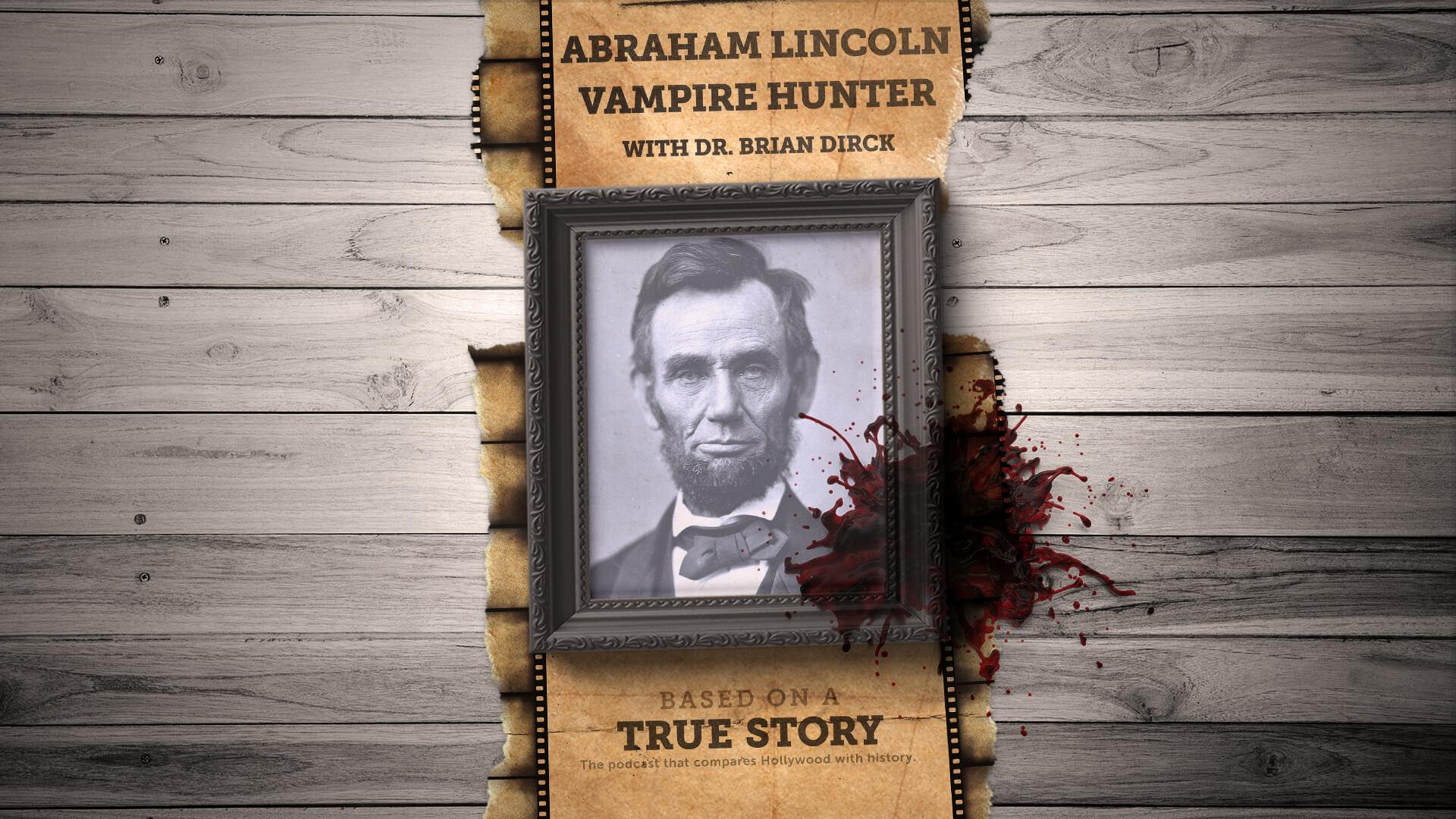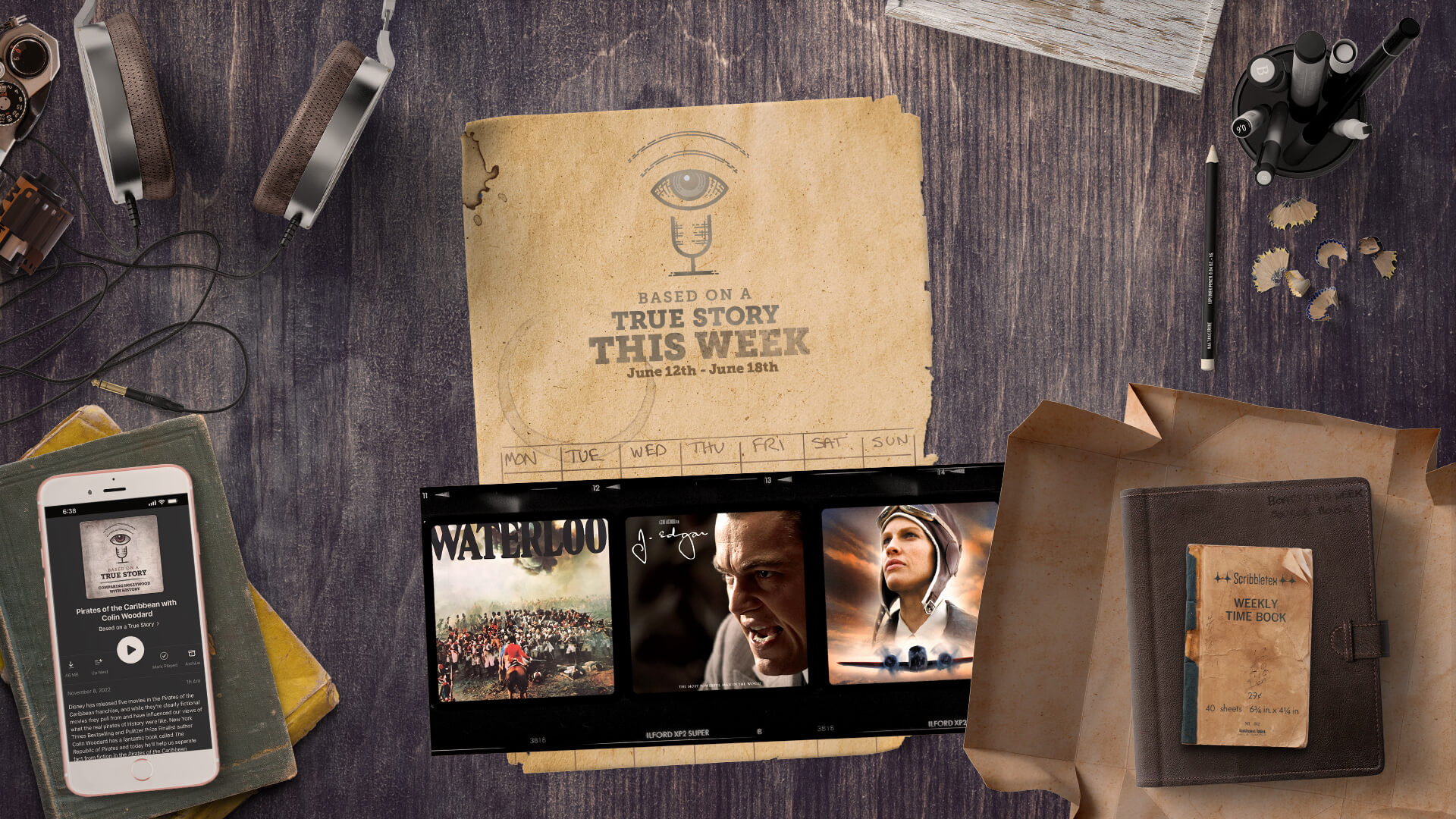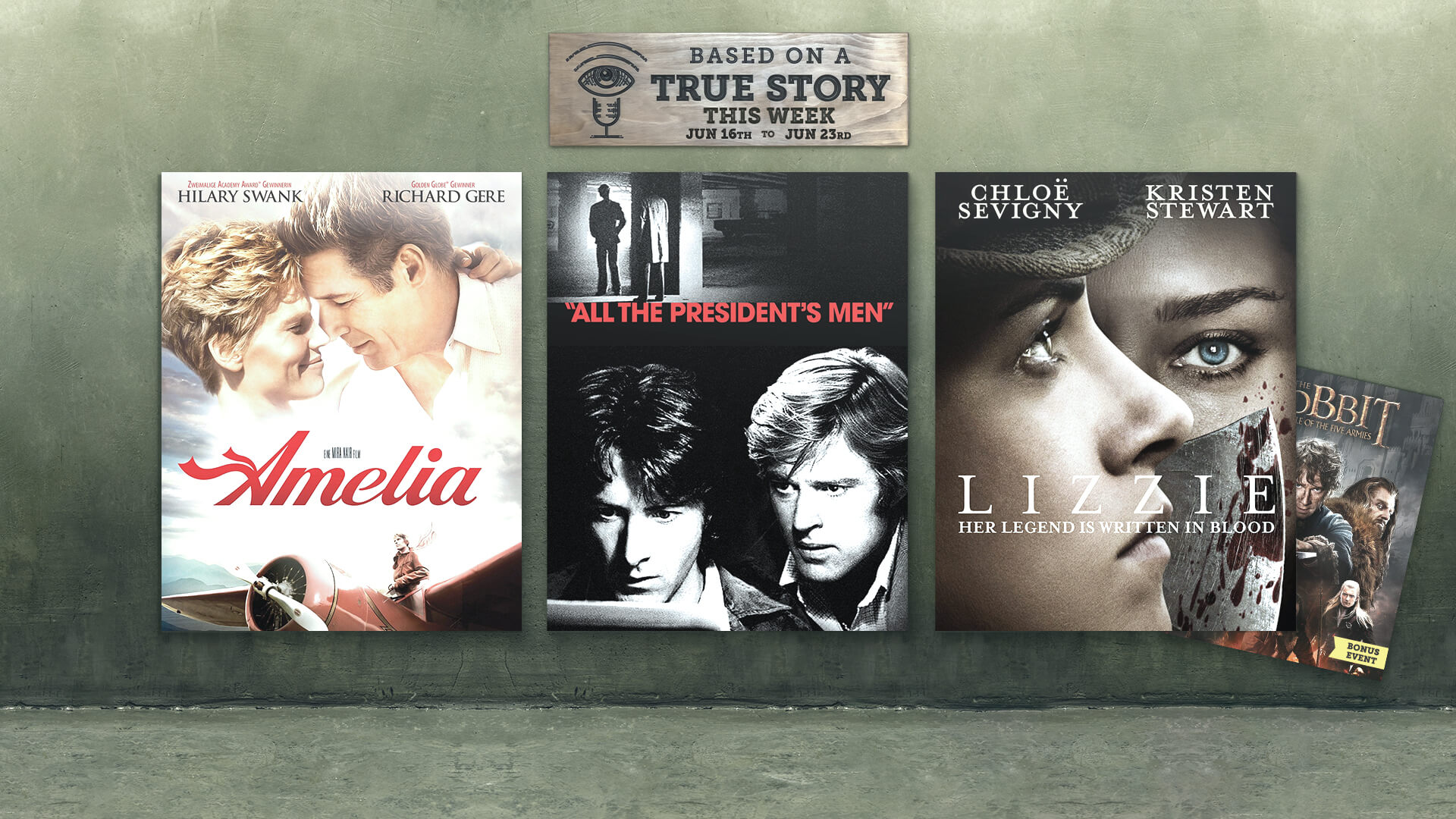In this episode, we’ll learn about historical events that happened this week in history as they were depicted in Hatfields & McCoys, The Walk, and Frost/Nixon
Did you enjoy this episode? Help support the next one!
Disclaimer: Dan LeFebvre and/or Based on a True Story may earn commissions from qualifying purchases through our links on this page.
Transcript
Note: This transcript is automatically generated. There will be mistakes, so please don’t use them for quotes. It is provided for reference use to find things better in the audio.
August 7, 1882. Blackberry Creek, Kentucky.
We’re outside. A few patches of green grass can be seen on the ground, but mostly there are brown leaves covering the ground and a few trees that look like they’ve already dropped their leaves for the season.
There are a number of different booths, tables, and wagons all set up to make a sort of crude circle. Modest decorations of red, white, and blue are strung between the circle, and if you look closely as the camera moves between the people milling about the event, there are signs hung up on some of the posts.
Does that one say “Thacker?” It’s hard to read as the camera is focusing mostly on the people dancing behind the pole the sign is hanging on. The next one is a lot easier to see. It reads:
District 2 Justice of the Peace
Vote Shadrick Osborn
That explains the red, white, and blue. This is an election.
It also seems to be a shooting contest, as some of the guys are taking aim at targets nearby.
Oh, and it’s a drinking party, too. Lots of the guys are carrying glasses filled with beer, or whiskey—we can’t tell what it is, but it’s clearly some sort of alcohol. Probably not a good thing to mix with shooting.
As time passes, the shooting competition continues to heat up between the competitors.
Then, we can see Kevin Costner’s version of Anse Hatfield walking arm-in-arm with his wife, Sarah Parish’s version of Levicy Hatfield. They walk one way while walking the other direction is Bill Paxton’s version of Randall McCoy walks arm-in-arm with his wife, Mare Winningham’s version of Sally McCoy. They pass by each other without saying anything or looking at each other.
From each side of the clearing surrounding by the circle of booths, the people start heckling the other side. One side seems to be the Hatfields, making fun of Randall McCoy. The other side seems to be the McCoys, making fun of Anse Hatfield.
The words start to escalate into name-calling. One of the McCoys warns one of the Hatfields about what he’s said, and taking off his coat he charges to the center of the circle. Others throw down their liquor and before long there’s a confrontation in the middle of the circle.
One of the men, Damien O’Hare’s version of Ellison Hatfield, tries to diffuse the situation and get the men to break up. It seems to work, and the Hatfields start walking back…then one of the McCoys marches up and punches someone in the back of the head. He falls to the ground. When he gets up, there are more words. More punches. Ellison tries to break it up again. Before long, it seems to be Ellison punching off the drunken McCoys as they keep coming at him.
Other Hatfields are just sitting back, drinking, and watching the fight as if it’s some sort of entertainment. And for a while, Ellison seems to be doing a good job of holding them off. In the fight, he seems to break one of the McCoys’ arms.
It looks like that’s Michael Jibson’s version of Phamer McCoy.
While on the ground, Phamer pulls out a knife with his good arm. He jumps on Ellison, stabbing him. It happens so fast, the other Hatfields watching and drinking don’t seem to realize the fight has escalated into something deadly. Ellison manages to get the man off him.
Then, Phamer pulls out a pistol. He turns, points it at Ellison, and pulls the trigger.
This is how the 2012 miniseries from the History Channel called Hatfields & McCoys depicts an event that happened this week in history when the family feud between the two families escalated into bloodshed.
Now, this is one of those events in history where we simply do not know the entirety of the true story. What we do know has to come from those who were there and, as you can probably guess, not everyone who was there had the same story to tell.
For one, witness testimony is never to be relied upon. Plus, this was in the 1800s in rural Kentucky, so it’s not like everything was documented.
On top of all of that, it was a feud. So, of course, those on the Hatfields side would recount the things that happened to favor their side while those on the McCoys side would favor their own side of the story.
With that historical caveat out of the way, for the most part, the History Channel’s series does a decent job of showing how it might’ve happened.
The name we see on the poster that I mentioned earlier, Shadrick Osborn, really was a real person. But, he’s not really involved in the true story we’re talking about today at all.
August 7th, 1882 was an election day for the area in Kentucky, and there was plenty of alcohol that factored into the escalation of a pre-existing disdain between the families. We don’t really know what the spark was that caused the violence to start. Some sources say it was because of how the Hatfields treated Roseanna McCoy—the sister of the McCoy brothers that started the violence in the series. So, it might’ve been similar to what we see in the series.
Regardless of how it started, though, we do know that the violence escalated when Ellison Hatfield was stabbed multiple times. Some sources say it might’ve been as many as 24 stab wounds.
We also see Ellison getting shot in the series, and while people there did say that happened, it probably didn’t happen while he was still standing up like we see in the series. After being stabbed, it’s more likely Ellison was on the ground when he was shot. He didn’t die right away, but there also wasn’t anything that could be done.
And as you can probably guess, there was retaliation from the Hatfields. It was led by Ellison’s brother, Anse—he’s played by Kevin Costner in the series. After local law enforcement was called, the McCoy brothers were arrested.
Conveniently enough, some of those law enforcement officers just happened to be Hatfields. So, it’s probably not too much of a surprise that Anse and some of his other family and friends were able to get the McCoy brothers out of the law’s custody before they made it to the closest jail.
After Ellison Hatfield succumbed to his wounds, Anse and his posse of vigilantes killed the McCoy brothers. Some sources say they fired over 50 bullets into the three McCoys.
And as you can probably guess, there was retaliation from the McCoys. And so, the feud between the Hatfields and McCoys turned into an especially bloody one this week in history.
If you want to watch this as it happened in the History Channel series, the segment we started today with is about five minutes into the second episode of 2012’s Hatfields & McCoys miniseries.
August 7, 1974. New York City, New York.
The camera is overlooking the city, giving us a beautiful view of the buildings below. The sun is just starting to rise in the distance. In the foreground, stretching from left to right across the frame is a wire of some sort. We can’t see what’s on either end, but the wire is in focus leaving the cityscape below to be slightly blurry.
Slowly, the camera pans to the right. As it does, we can see what the wire is connected to as a massive metal structure starts to fill up the frame. The camera stops as a foot enters the top of the frame. Wearing what looks like a black slip-on shoe of some sort, the foot reaches down until it steps onto the wire. We can also see at least one leg of what we can assume are black pants.
Then, the camera pans up the leg and back slightly.
Now we can see who the foot and leg belong to: Joseph Gordon-Levitt’s version of Philippe Petit.
Behind him, the structure we saw a moment ago is also easier to see. It’s the rooftop of a big building. At least it looks big, part of it seems to be obscured by the morning fog. Another man is standing up there with him. He’s handing Philippe what looks like a long, metal rod.
The camera cuts back to looking at his feet now. Except instead of looking at the structure where he’s at, the shot is looking from behind his feet, across the wire, to the other side.
So, now we can see on the right side of the frame is the structure that dialogue in the movie confirms is a building. One of Philippe’s feet is on the building. The other one is a step down, carefully placed on the wire. That wire stretches from the building Philippe is partially on, across a gap covered in fog and to a building on the other side of the frame—that building is also partially covered by the fog.
A few seconds pass, and the fog rolls by a little bit more, covering up whatever we could see on the other side. Now the wire just looks like it’s going into nothingness. The fog continues to grow, as Philippe’s inner monologue explains that the sounds of New York faded below him: All I could see was the wire.
A moment passes as Philippe surveys the scene in front of him.
And then, carefully, Phillipe takes his foot off the building and places it on the wire.
This is how the 2015 movie called The Walk shows something that happened this week in history when Phillipe Petit walked a highwire stretched between the two World Trade Center buildings in New York City on August 7th, 1974.
And not to spoil the ending of the movie, but he did make it across. I’m guessing you already knew that part of it is true, too, since they probably wouldn’t have made a movie about it if he hadn’t been successful.
To quote from Sony Pictures’ official summary posted over on IMDb, “Twelve people have walked on the moon, but only one man – Philippe Petit (Joseph Gordon-Levitt) – has ever, or will ever, walk in the immense void between the World Trade Center towers.”
The walk between the towers wasn’t some random event.
Walking between the towers was something Phillipe Petit wanted to do ever since he found out they were being built in 1968—well, technically, the construction for the towers began in 1967, but Petit found out about them in 1968.
In 1971, he walked between the two towers of the Notre-Dame Cathedral in Paris. He got arrested for that since it’s illegal to do that. But, he got free and in 1973, he walked between pylons on the Sydney Harbour Bridge in Australia. Back in New York City, the two towers of the World Trade Center had their ribbon-cutting ceremony in April of 1973.
Then, in early 1974, Petit visited New York City. He also knew he’d have to compensate for both the wind as well as the towers moving, too. Standing 1,360 feet tall, the towers were designed to sway in the wind. So, he had a lot of preparation to do.
He took reconnaissance photos. He practiced on similar distances.
But, the walk itself was just part of it. They had to get the line secured. And they had to do it in a way that no one would know they’re doing it. After all, what he did was technically illegal.
In fact, many people have called his feat the ‘artistic crime of the century.’
The night before, on August 6th, Petit and a few people helping him, snuck up to the south tower. Well, most of them.
A couple of the guys helping him went to the north tower. From there, they used a bow and arrow to shoot fishing line between the towers. Since it was dark and fishing line isn’t very easy to see to begin with, it took a while for Petit to find on the other side.
He even had to take off his clothes to feel around with more of his skin to find the line. Once they did, the steel wire was pulled between the towers and after much effort, finally secured.
The walk itself took place at about 7:15 AM local time on August 7th, 1974.
It took about 45 minutes for Petit to span the distance between the towers. But, then again, he didn’t do it just once. All that work wasn’t for a single trip. He went back and forth eight times.
Oh, and to do some conversions, the towers are 1,360 feet tall so about 414 meters with a distance between them of 200 feet, so about 61 meters. Although I also found some sources saying Petit’s cable was 131 feet long, so about 40 meters, which could make sense that whoever measures the distance between the towers aren’t measuring for a cable connecting them, haha!
Just like we see in the movie, a crowd below gathered to see it happen. And as you can probably guess, police showed up on the other side to arrest Petit as soon as he stepped off the wire. He was released that afternoon—after a psych eval to make sure he was okay, of course. The only condition of his release was that he do a free performance in Central Park.
If you want to watch the event that happened this week in history, check out the 2015 movie called The Walk. The sequence we started our segment with today starts at about an hour, 28 minutes and 11 seconds into the movie.
August 8, 1974. Washington DC.
We’re looking over the shoulder of a man as he’s reviewing the papers on the desk in front of him. From somewhere off-screen, we can hear a man saying, “15 seconds, Mr. President.”
The camera cuts to…well, another camera. There are two red lights above the camera as the countdown continues.
“Five, four…”
We can see the President’s cufflinks in a closeup shot as he straightens the papers. They’re in his hands, now.
Then, he begins the speech.
“Good evening, this is the 37th time I have addressed you from the office,” he says into the camera on the other side of the desk.
That’s how the 2008 movie called Frost/Nixon depicts an event that happened this week in history when, on August 8th, 1974, President Richard Nixon announced to a live television audience that he would resign the Presidency effective the following day, making him the first president in the history of the United States to resign.
And that really is how Nixon started his speech that day, but in the movie we don’t see much of the speech before it cuts away. And I can understand why they decided to do that in the film—if for no other reason than the speech was about 15 minutes long.
That’s a lot to include in the movie, especially since the point of the movie is what happened after the speech and not the speech itself. But since they show how the speech began in the movie, let’s hear the first few minutes of the real speech…and then if you want to see the original television broadcast, I’ll include that over at basedonatruestorypodcast.com/267
And then Nixon continued the rest of the speech.
If you want to see the full speech, you can watch a clip of the original broadcast over at basedonatruestorypodcast.com/267
But that’s not the only thing from this week in history relevant to the true story.
The next day, at about noon on August 9th, 1974, President Nixon officially stepped down and the office of the President was transferred to Vice President Gerald Ford who, then, became the 38th President of the United States.
And then almost exactly a year later, on August 10th, 1975—so also this week in history—David Frost bought the rights to an exclusive interview with former President Nixon. That’s the story told in the 2008 movie Frost/Nixon, so if you want to see the event that happened this week in history, the text on the screen saying it’s August 8th, 1974, is at about four minutes and two seconds into the movie. And then the rest of the movie is about David Frost’s interview with Nixon.
And we covered that movie way back in the single digits—episode number four of Based on a True Story.
Share this:
- Click to share on Twitter (Opens in new window)
- Click to share on Facebook (Opens in new window)
- Click to share on Reddit (Opens in new window)
- Click to share on Pocket (Opens in new window)
- Click to share on LinkedIn (Opens in new window)
- Click to share on WhatsApp (Opens in new window)
- Click to share on Telegram (Opens in new window)
- Click to email a link to a friend (Opens in new window)
- Click to print (Opens in new window)



